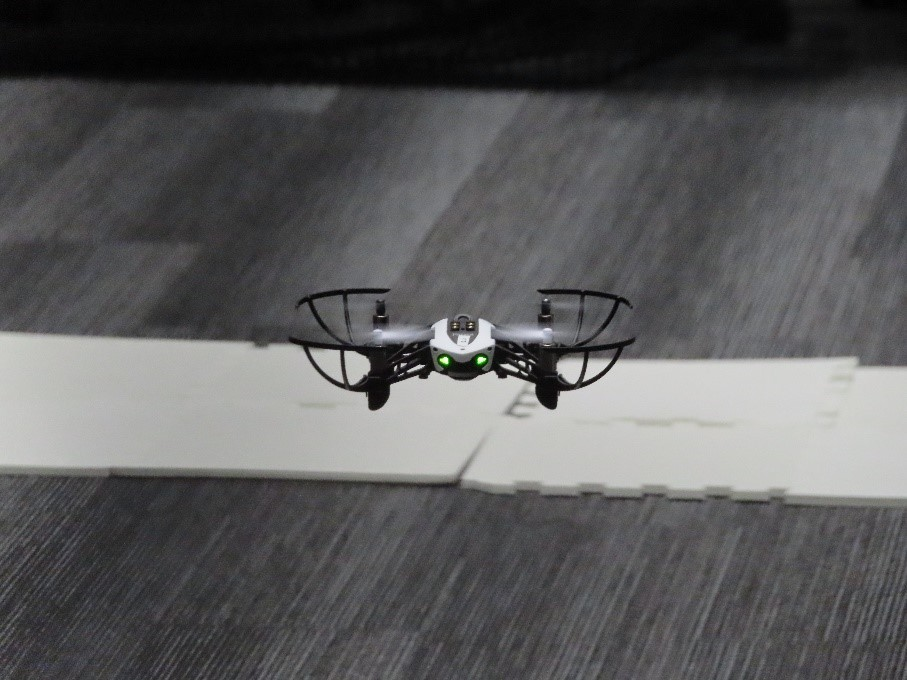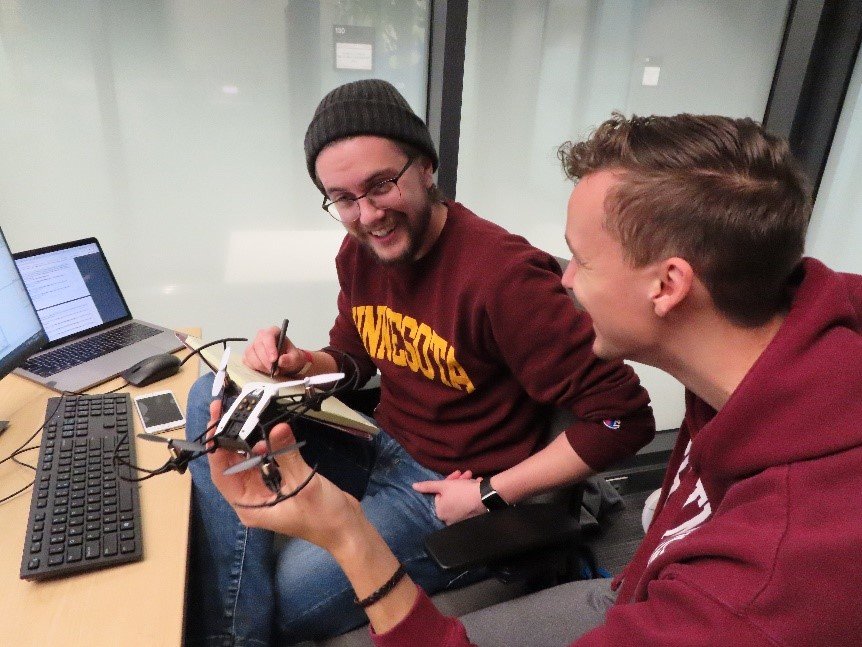Drones Take Flight

AEM 4602W
From light shows to combatting invasive species, drones have become an increasingly important part of society. As technology continues to improve, innovative research with drones has become a focus for many including the professors and researchers in the department of Aerospace Engineering & Mechanics. Our students have the opportunity to tackle drone research in various courses but recently, they’ve been able to test and fly drones in AEM 4602W, Aeromechanics Laboratory
Taught in Fall 2019 by Professor Derya Aksaray, students in AEM 4602W worked with the Parrot Mambo drone and investigated the influence of the controller parameters on drone’s dynamical behavior. Drones are desired to maintain a desired position and attitude. However, they are subject to various disturbances in flight and they might deviate from their original position. For such cases, stability is an important system behavior. A stable system tends to return to its original position after a disturbance. Nonetheless, a stable system can return to its original position in various ways.
Professor Aksaray explained that there could be oscillatory behavior while the drone attempts to return its original position. “…all these different types of behaviors can be generated by different control gains that we use in the controller.” Typically, many undergraduate courses focus on theoretical aspects such as how to design the controller, how to pick a gain, what kind of behaviors might be observed, or how to simulate the behavior. The purpose of this class is to take those theories and actually experiment how the drones will react when using different gains.
“In a nutshell,” Aksaray continued, “we designed an experiment where this drone is supposed to go to a specific altitude…then hover there for a while before it lands.”
Students in the class spend the first couple of weeks in lecture what to anticipate, what is the dynamical system, how to evaluate the response of a dynamical system, how to design a PID controller, and related topics. The lectures continue after this, but the hands on experiment then begins. While plotting and flying drones, the discussion focuses on how to interpret the data they collect and how to write a formal report on their findings as they will be evaluated on the report they write. Professor Aksaray mentioned that this experience including critical thinking and data interpretation will assist students in their future jobs. Interpretation of data is key while working with theories and conclusions. Problems or different behaviors will arise and one must be able to justify or present this data in a formal way.
Location & Set Up
Professor Aksaray researches drones in her lab in Akerman, but the drone lab in Shepherd (shared specifically for MnRI) has some different features making it an ideal location for the experiment section of the course. “The Shepherd lab is a new indoor flight facility which has a high ceiling, sufficiently large area, and an advanced motion capture system different than [the one] I use in my lab…”
However, setting up for this course was no easy project. It took several months (starting in the summer) and was definitely a group effort. Professors Pete Seiler, Ryan Caverly, Yohannes Ketema, Caverly’s students Casey Carlson and Robert Halverson, and lab coordinator Kale Hedstrom were invaluable in the preparation of this experiment. Besides hauling equipment and setting up, they provided quite a lot of research such as hovering data. This data helped design the experiments for 4602W.
Casey Carlson and Robert Halverson, AEM undergraduates, worked with the Parrot Mambo drone previously and helped pave the road for the experiments with their research. Part of Professor Caverly's goal for them was working with this drone to test their own controller in flight and in simulation. They were able to swap out three existing controllers (one each for roll, pitch, and yaw) with one controller. Caverly also had them learn how the drone interfaces with Matlab which were used in 4602W.
Research and Data
On this project, Carlson explained, “My work started with learning how to use the Simulink model which serves to control and model the drone in flight. It took a while to understand how the whole thing worked because of how many different layers it has, but just trying different things and learning how the different subsections worked helped me to figure out how it works as a whole.”
Halverson also added that they utilized this existing Simulink code to modify the drone controller and determine its data acquisition methods. He also mentioned the complexity of understanding it, “There was a lot of time spent experimenting with different parameters in the code, and finding out the physical flying limits on the drone to determine safety 'rules' for the lab. I focused mainly on how to take data from the drone to then be plotted post-flight.” He continued, “Once we had this all figured out, Casey and I collaborated on finding different control gains which each lead to different physical responses used in the lab.”
For the 4602 lab, Carlson worked on figuring out the visualization of data acquired from flight tests in order to easily analyze data. The two students wrote MATLAB scripts to initialize and automate this process, and upon completion, they found sets of proportional and derivative gains to achieve different performances in the altitude controller so that this effect could be seen in the lab.
The AEM Department and Professor Aksaray extend their thanks to these students, faculty, and staff involved in putting this experiment together.

Plans for the Future
Students thinking about enrolling in AEM 4602W can possibly look forward to more drone experiments in the future. Improvements will be made to this year’s base experiment. Professor Aksaray says to consider it a skeleton to build on.
“…this is like the base experiments. Our goal is to continue these experiment series in the following years and definitely…improving it based on the experience we gain, and every year based on the feedback we receive back from the students so definitely this is the skeleton of the control experiments in 4602W. Hopefully in the following years, we will evolve the experiment and make it include some other aspects.”
The department shares Professor Aksaray’s excitement for this project and looks forward to the development of more drone experiments. “I’m really happy to be in this course, and I’m also very excited by having this experiment in the department and hopefully improving it and making [it] better and better every year.”